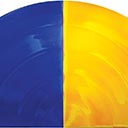Waterfall
85 x 58 cm
est. $350,000 - 450,000
Colin McCahon database, record number cm001097
McCahon's 'waterfall' landscapes, reworked 'through' Hodges, and relocated environmentally to the Waitakere Ranges west of Auckland, are also based in part, as McCahon was to acknowledge to several of their purchasers, on specific waterfalls in the Waitakere Ranges Regional Park such as the Fairy Falls, Kitekite Falls and Karekare Falls. This important painting, Waterfall 1964, is one of the few larger compositions that draws directly upon specific details of Hodges' [Cascade Cove], Dusky Bay: water crashing down onto rocks in a pool, banks of golden tree foliage, a yellow ('Naples yellow'?) scar on the hillside, waves scudding on the pool below. These details and size were soon to be pared back, and a 'McCahon waterfall' typically became an elemental white column of falling water, often viewed from an angle so it appeared to silently curve its way through the darkness. In a Christian reading of these works, McCahon's son, William, has argued that McCahon saw the waterfall: 'as the earth bleeding -a sacrament of light issuing from the land recalling the blood shed by Christ in his Passion; Christ becoming the earth'.i
As well as the influence of Hodges, there was a second impetus propelling McCahon's waterfalls. This was his concern for the environment, what we might call his 'ecological consciousness'. In most of McCahon's Waterfalls the removal of skyline draws the viewer into the composition, encouraging identification with elemental water, earth and bush. In later catalogue entries McCahon specifically links the Necessary Protection paintings of the 1970s to his earlier Waterfall series and he makes it clear his painting was not done merely to protest the degradation of the landscape, but in some way to stay environmental devastation and depletion, and to restore an equilibrium in human interaction with the earth
'I am painting about what is still there and what I can still see before the sky turns black with soot and the sea becomes a slowly heaving rubbish tip. I am painting what we have got now and will never get again. This, in one shape or form, has been the subject of my painting for a very long time.' p. 216. Nelson: Craig Potton, 2002
In the early 1960s Colin McCahon, as Keeper and Deputy Director of the Auckland City Art Gallery, was instrumental in organising and installing an exhibition entitled Captain James Cook: His Artists and Draughtsmen held at the gallery between October and December 1964. In particular McCahon responded to a painting by William Hodges, the painter who accompanied Cook on his second voyage to the Pacific, [Cascade Cove], Dusky Bay, c. 1775-6, found today in the National Maritime Museum, London. Later in a catalogue note to his own survey show McCahon wrote that his own series of 'waterfalls': grew out of William Hodges' paintings on loan to the Auckland City Art Gallery from The Admiralty London. 'Hodges and I eventually realized we were friends over the years and got talking about his painting. He was dead and I was about the same. We conversed, through paint (about Naples yellow to start with) - and in 1964 I painted my first waterfall. Hodges is my hero in all these paintings...' Laurence Simmons
p. 32 Colin McCahon, Colin McCahon: A Survey Exhibition, Auckland City Art Gallery, 1972, p. 31, Colin McCahon: A Question of Faith, Marja Bloem and Martin Browne, Stedelijk Museum Amsterdam





